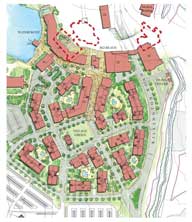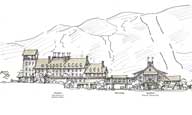| << | April 2025 | >> | ||||
| S | M | T | W | T | F | S |
| 1 | 2 | 3 | 4 | 5 | ||
| 6 | 7 | 8 | 9 | 10 | 11 | 12 |
| 13 | 14 | 15 | 16 | 17 | 18 | 19 |
| 20 | 21 | 22 | 23 | 24 | 25 | 26 |
| 27 | 28 | 29 | 30 | |||
New Killington Village plans outlined to Killington Planning Commission.
The writing of the next chapter in the history of the town of Killington may have begun last evening at the Sherburne Memorial Library. Before an overflow crowd in excess of 100 people, Steve Selbo, president of SP Land LLC, unveiled preliminary plans for the construction of a village at the base of the Killington Resort to the Killington Planning Commission. Assisting Steve in the presentation was Paul Rowsey from E2MPartners, the principle investors in the project. In addition to Steve and Paul, assistance in the presentation was provided by Carl Spangler, who presented an overview of the checkered history of Killington Village proposals, Dwight Demay, lead planner for Hart Howerton, a land planning firm hired by SP Land to design the village concept, and Doug Wright, an architect for Hart Howerton.
The purpose of the meeting was to begin the formal process of requesting approval from the Town of Killington and the State of Vermont to begin development of the Killington Village. This was an informational meeting only, meant to educate the Planning Commission and the general public on the concepts for the village being proposed for development by SP Land.
The overall village development falls under a town plan concept called a "Planned Unit Development", often referred to by it's acronym "PUD". "PUD's" allow a developer to seek permission from the town to develop a land parcel, usually containing a variety of compatible land uses, as a cohesive development with zoneing regulations specific to the "PUD". Within the town of Killington, "PUD"s are generally granted for a 4 year period. If a developer needs additional time to complete development of the PUD, generally 2 extensions of up to 4 years each are granted.
In the case of the Killington Village development, an existing PUD is in place which expires in September. With the informational meeting completed, SP Land intends to file a PUD renewal request with the Killington Planning Commission to extend the authorization of the current PUD. This is the first step in a long process which, after the PUD is renewed or a new PUD issued, will see SP Land filing for ACT 250 approval from the State of Vermont, and various site specific permits from the Town of Killington to begin construction of the various elements of the proposed village.
Act 250 governs land use in Vermont, establishing specific criteria which a developer must meet before going forward with a commercial project. SP Land estimated that the Act 250 process would cost several millions of dollars in expense and at least 9 to 12 months on the calendar. SP Land seeks renewal of the PUD from the Town of Killington before beginning the Act 250 process. Support by a town for a commercial development is one of the criteria used by the applicable Vermont District Environmental Commission, in this case Rutland County, to determine if an Act 250 application can be approved. SP Land committed to provide the renewal request paperwork to the Killington Planning Commission "within 2 to 4 weeks". The Town Planning Commission will then hold a public hearing on the request prior to accepting or rejecting it. Based upon the overflow crowd at the meeting, one of the the planning commissioners suggested that the public hearing take place at the Sherburne Elementary School, as that has an auditorium suitable for a large public gathering. No date has been set for that hearing.
The village proposal that was outlined encompasses many phases. According to Mr. Selbo and other presenters, Phase 1 of the development is well into the planning process. Phase 2 and beyond have undergone various levels of conceptual testing to evaluate their feasibility, but as the overall development effort will last many years, later phases of the project are not yet in a state for permit application. Selbo and Rowsey did tell the assembled crowd that they expected that future phases of the development would go forward. Because of the infrastructure work required to complete Phase 1, follow on phases would be required for E2MPartners to make a return on their investment.

|
| Killington Village plan presented by SP Land Current Snowshed and Rams Head base lodges outlined in red. (Click to enlarge.) |
Phase 1 of the Killington Village development encompasses 6 mixed use buildings (building 1A through 1G on the Village Land Plan), the creation of a new Skier Services Center/Base Lodge (building 1X) to replace the current Snowshed and Rams Head base lodges, construction of a transportation center, construction of a tunnel to divert the Killington Road under the Skier Service Center, and creation of a new ski area concept called "Ski Beach". "Ski Beach" will regrade the Snowshed and Rams Head base areas to provide a contiguous surface to allow skiers and riders to link between mountain areas. Today, skiers and riders must transit through a tunnel under the Killington Road to connect between base areas. In the new "Ski Beach" concept, both base areas would be at the same elevation, with the Killington Road transiting under the area in a tunnel.
The architecture of the new village will be modeled along traditional New England village lines with a central village green. Around the green, the 6 buildings in the central village of phase 1 will be mixed use including residential and commercial space. Street Level areas will be primarily dedicated to commercial space. 157 units of residential space are included in the initial village plan around the green.
The new Skier Services Center would reflect the "New England" style of architecture. Doug Wright, the lead architect for Hart Howerton, stated that this building should be "substantial and significant" in nature, befitting it's place in the overall village development, and in the level of services it will provide to skiers visiting the Killington Resort.

|
| New Skier Services Center to replace current Snowshed and Rams Head base lodges. (Click to enlarge.) |
In addition to the central village, SP Land also intends to develop 42 residential units in an area it calls "Rams Head Brook". "Rams Head Brook" is located approximately to the right of the entrance to the current Rams Head parking lot, which will disappear according the the plan discussed. Additional residential units would be built over time as commercial viability and market conditions warrant.
After the presentation, a brief question and answer session was held. A variety of people asked questions that revolved around the theme "How will this project affect me?". These were politely answered by Mr. Selbo and his associates. The most telling question, in my estimation, was one of the simplest: "When will the development start?" Mr. Selbo, aware of the vacuity of the Act 250 process politely responded that he was not sure. "It depends on how we progress through the approval process". Mr. Rowsey was much more direct. "As soon as we get approvals from the state, and permits issued by the town, we will start building the village". I suspect that the number and quality of questions will increase substantially as people have an opportunity to review the provided plan in preparation for the to be scheduled Planning Commission hearing on the pending PUD renewal application. Interested parties desiring to inspect the material provided by SP Land can contact Dick Horner, Killington Town Planning and Zoning Administrator, at the Killington Town Offices at (802)422-3242.
Only time will tell on whether or not the development of a Village at Killington will be a success. The level of detail presented at yesterdays meeting exceeds the complexity one can reasonably write about in a single blog posting. The development plan must first, properly, go through a long and complex process of evaluation at both the local and state levels. Millions of dollars, the local economy, the ability of the area to continue to attract visitors, and the character of both the town and resort of Killington are at stake. The Chinese did get it right...we live in interesting times.
Let it snow!


